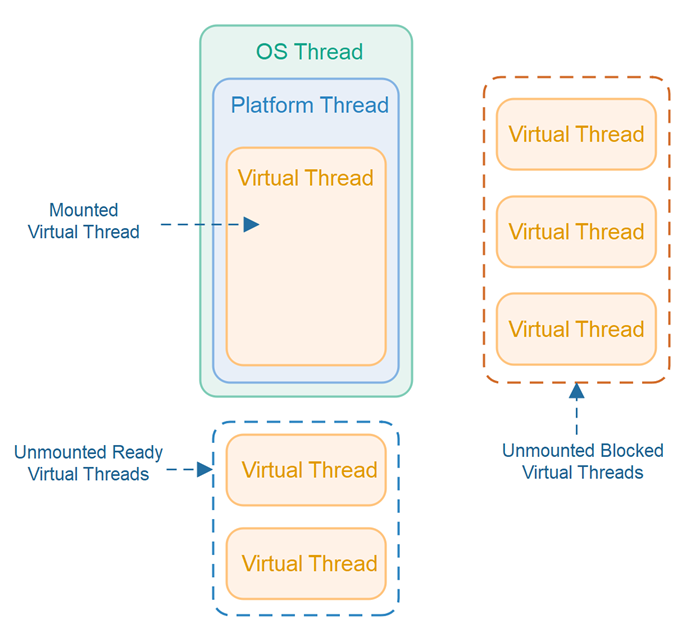In the ever-evolving landscape of software development, performance remains a cornerstone of application quality. For Java developers, mastering concurrency is the key to building scalable, responsive, and efficient systems capable of handling the immense workloads of the modern era. While multithreading has been a fundamental part of the Java platform since its inception, recent advancements, particularly with the finalization of Project Loom in Java 21, have revolutionized how we write and think about concurrent code. This is a major piece of Java performance news that promises to simplify development while dramatically boosting throughput for I/O-bound applications.
This article explores the journey of concurrency in Java, from traditional platform threads to the lightweight paradigm of virtual threads. We will delve into practical code examples, discuss the new structured concurrency APIs, and outline best practices for leveraging these powerful features in your own projects. Whether you’re working with the latest Spring Boot applications or maintaining legacy enterprise systems, understanding this shift is crucial for staying ahead in the vibrant Java ecosystem news cycle.
The Evolution of Concurrency in Java: From Heavyweight to Lightweight
Java’s approach to concurrency has undergone a significant transformation. What began with a direct mapping to operating system threads has evolved into a sophisticated, JVM-managed system designed for massive scale. Understanding this evolution is key to appreciating the benefits of the latest features.
The Classic Model: Platform Threads
For decades, Java’s concurrency model was built exclusively on platform threads. These are thin wrappers around the operating system’s (OS) native threads. While powerful, they come with significant limitations:
- Heavyweight Nature: Each platform thread consumes a considerable amount of OS resources, including its own stack memory. This limits the total number of threads an application can create to a few thousand at most.
- High Context-Switching Cost: When the OS switches between threads, it incurs a performance penalty. With many threads, this overhead can become a major bottleneck.
- Resource Underutilization: In typical I/O-bound applications (e.g., microservices calling databases or other APIs), a thread often blocks, waiting for a response. While blocked, the thread holds onto its resources but does no useful work, leading to inefficiency.
The traditional way to manage these threads is with an ExecutorService, which pools and reuses platform threads to mitigate the cost of their creation and destruction.
import java.util.concurrent.ExecutorService;
import java.util.concurrent.Executors;
import java.util.concurrent.TimeUnit;
// A classic example of using a fixed pool of platform threads.
public class PlatformThreadExample {
public static void main(String[] args) throws InterruptedException {
// Create a thread pool with a fixed number of platform threads (e.g., 100)
try (ExecutorService executor = Executors.newFixedThreadPool(100)) {
for (int i = 0; i < 1000; i++) {
int taskNumber = i;
executor.submit(() -> {
// Simulate an I/O-bound task, like a network call
System.out.println("Executing task " + taskNumber + " on thread: " + Thread.currentThread());
try {
Thread.sleep(1000); // Simulate blocking I/O
} catch (InterruptedException e) {
Thread.currentThread().interrupt();
}
});
}
} // executor.shutdown() is called automatically by try-with-resources
}
}In this example, only 100 tasks can run concurrently. The other 900 tasks must wait in a queue for a thread to become available. This is a classic bottleneck in high-throughput systems and a central theme in Java 8 news and Java 11 news performance discussions.
The Game Changer: Project Loom and Virtual Threads

The most exciting Java 21 news is undoubtedly the finalization of Project Loom, which introduces virtual threads to the JVM. Virtual threads are a lightweight implementation of threads managed by the Java runtime, not the OS. This fundamental change addresses the core limitations of platform threads.
What Are Virtual Threads?
Virtual threads are cheap to create and have a negligible memory footprint. You can create millions of them without overwhelming the system. The JVM runs them on a small pool of underlying platform threads, known as carrier threads. When a virtual thread executes a blocking I/O operation, the JVM automatically “unmounts” it from its carrier thread, freeing the carrier to run another virtual thread. Once the I/O operation completes, the virtual thread is “mounted” back onto an available carrier to resume execution. This process is transparent to the developer and delivers the scalability of asynchronous programming with the simplicity of traditional, synchronous-style code.
Migrating to Virtual Threads: A Practical Example
One of the most compelling aspects of this Project Loom news is the ease of adoption. The API is intentionally familiar. To adapt the previous example to use virtual threads, only one line of code needs to change.
import java.util.concurrent.ExecutorService;
import java.util.concurrent.Executors;
import java.util.concurrent.TimeUnit;
// The modern approach using a virtual thread per task.
public class VirtualThreadExample {
public static void main(String[] args) throws InterruptedException {
// Create an executor that starts a new virtual thread for each task.
// This is the key change!
try (ExecutorService executor = Executors.newVirtualThreadPerTaskExecutor()) {
for (int i = 0; i < 1000; i++) {
int taskNumber = i;
executor.submit(() -> {
// The task logic remains identical.
System.out.println("Executing task " + taskNumber + " on thread: " + Thread.currentThread());
try {
Thread.sleep(1000); // Simulate blocking I/O
} catch (InterruptedException e) {
Thread.currentThread().interrupt();
}
});
}
} // executor.shutdown() is called automatically
}
}With this simple change, the application can now create 1,000 virtual threads and run all tasks concurrently without waiting. The JVM will manage scheduling these onto a small number of platform threads (typically equal to the number of CPU cores). This is a monumental leap for Java performance news and is already being adopted in the latest Spring Boot news, with Spring Boot 3.2 offering first-class support for virtual threads.
Advanced Concurrency: Structured Concurrency and Scoped Values
Project Loom is more than just virtual threads. It also introduces new APIs to manage concurrent operations in a more robust and maintainable way. This is a core part of the latest Java SE news.
Simplifying Concurrent Lifecycles with Structured Concurrency
A common challenge in concurrent programming is managing the lifecycle of multiple related tasks. If one task fails, how do you reliably cancel the others? How do you ensure all tasks are complete before proceeding? Structured Concurrency, a preview feature in Java 21, solves this by treating concurrent tasks as a single unit of work.

The primary tool for this is the StructuredTaskScope. It ensures that all tasks forked within a scope must complete before the main thread can exit the scope. This creates a clear, hierarchical relationship between parent and child threads.
import java.util.concurrent.Future;
import jdk.incubator.concurrent.StructuredTaskScope;
// Represents a response from a service call
record UserData(String name, String data) {}
public class StructuredConcurrencyExample {
public UserData fetchUserData(long userId) throws Exception {
// Create a scope that shuts down on the first failure.
try (var scope = new StructuredTaskScope.ShutdownOnFailure()) {
// Fork two concurrent tasks.
Future<String> userNameFuture = scope.fork(() -> fetchFromServiceA(userId));
Future<String> userDataFuture = scope.fork(() -> fetchFromServiceB(userId));
// Wait for both tasks to complete or one to fail.
scope.join();
scope.throwIfFailed(); // Throws an exception if any task failed.
// If successful, combine the results.
return new UserData(userNameFuture.resultNow(), userDataFuture.resultNow());
}
}
// Dummy service methods
private String fetchFromServiceA(long userId) throws InterruptedException {
Thread.sleep(200);
return "John Doe";
}
private String fetchFromServiceB(long userId) throws InterruptedException {
Thread.sleep(300);
return "User Profile Data";
}
}This code is much cleaner and safer than managing `CompletableFuture` objects manually. If `fetchFromServiceB` fails, the scope automatically cancels the `fetchFromServiceA` task (if it’s still running) and propagates the exception. This is a key piece of Java structured concurrency news that greatly improves the reliability of concurrent code.
Best Practices and Performance Optimization in the Age of Virtual Threads
Adopting virtual threads requires a slight shift in mindset. While the code looks familiar, the underlying mechanics are different. Following best practices is essential to unlock their full potential.
When to Use (and Not Use) Virtual Threads
Virtual threads excel in I/O-bound or “waiting-bound” scenarios. This includes:

- Microservice API calls
- Database queries (with modern JDBC drivers)
- Message queue operations
- File system access
They are not a silver bullet for CPU-bound tasks, such as complex calculations, data compression, or image processing. For these workloads, the performance is limited by the number of CPU cores, and using a pool of platform threads matching the core count remains the optimal strategy.
Common Pitfalls to Avoid
- Do Not Pool Virtual Threads: Virtual threads are designed to be created on demand (“new virtual thread per task”). They are so cheap that pooling them is an anti-pattern that adds unnecessary complexity and can even hurt performance.
- Beware of Thread Pinning: A virtual thread can become “pinned” to its carrier platform thread if it enters a `synchronized` block or executes a native method. While pinned, it cannot be unmounted, and the carrier thread is blocked. Extensive pinning can undermine the scalability of virtual threads. The modern alternative is to use `java.util.concurrent.locks.ReentrantLock` instead of `synchronized` blocks in performance-critical sections.
- Update Your Libraries: Ensure that your dependencies, especially database drivers and HTTP clients, are updated to be virtual-thread-aware to avoid pinning. This is a fast-moving area in the Hibernate news and general Jakarta EE news space.
Tooling across the ecosystem, from build tools like Maven and Gradle to testing frameworks like JUnit and Mockito, fully supports the latest Java versions, making the transition smooth. The latest OpenJDK news and builds from vendors like Azul Zulu, Amazon Corretto, and BellSoft Liberica all include these finalized features.
Conclusion: The Future of High-Performance Java
The introduction of virtual threads, structured concurrency, and scoped values in recent Java releases represents the most significant evolution in Java concurrency in over a decade. This is not just incremental improvement; it’s a paradigm shift that enables developers to write simple, maintainable, and highly scalable code without the complexities of asynchronous programming. By embracing the “thread-per-request” model with lightweight virtual threads, Java solidifies its position as a top-tier platform for building modern, cloud-native applications.
As a developer, the next step is clear: start experimenting with these features in Java 21. Convert an existing I/O-bound service to use `newVirtualThreadPerTaskExecutor()` and measure the performance gains. Explore `StructuredTaskScope` to refactor complex concurrent workflows. By staying current with this vital Java performance news, you can build more robust, efficient, and scalable applications that are ready for the future.

